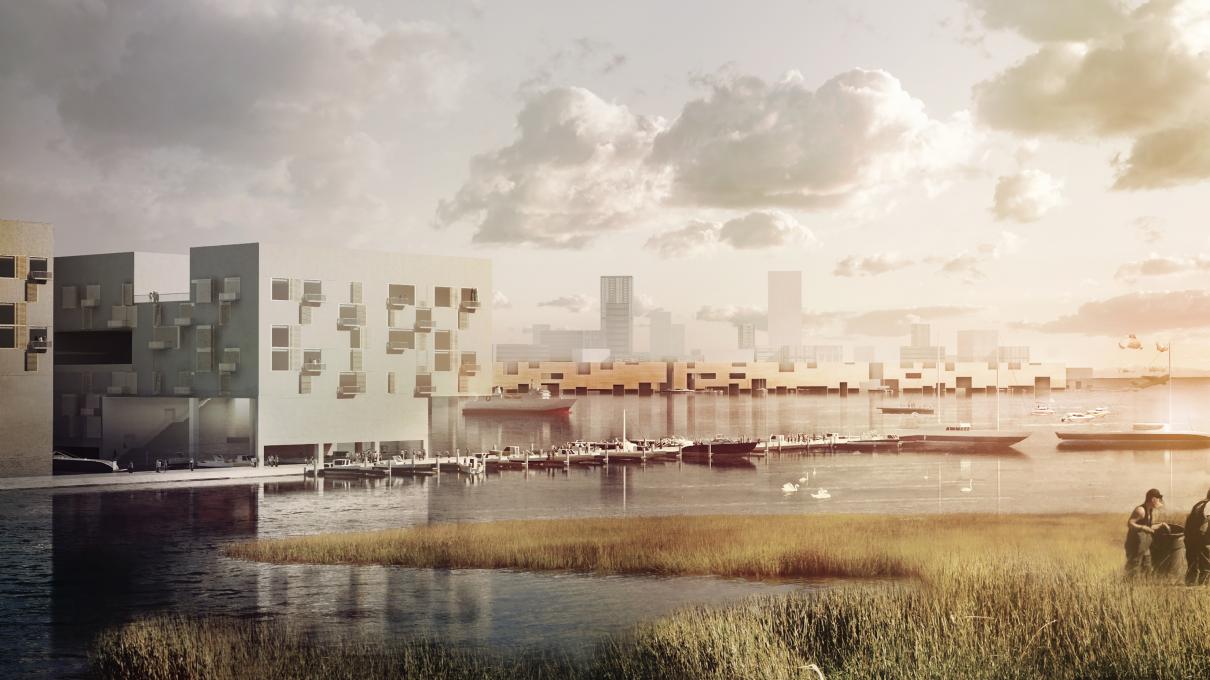A Blueprint for Coastal Adaptation: Uniting Design, Economics, and Policy

The Norman B. Leventhal Center for Advanced Urbanism has been collaborating with the Ian McHarg Center for Urbanism and & Ecology, and the Wharton Risk Management and Decision Process Center of the University of Pennsylvania on a new book: A Blueprint for Coastal Adaptation: Uniting Design, Economics, and Policy.
In the book, coastal adaptation experts discuss the interrelated challenges facing communities experiencing sea level rise and increasing storm impacts. Addressing far-reaching problems from cleaning up contaminated, abandoned sites, to changes in drinking water composition, A Blueprint for Coastal Adaptation identifies a bold new research and policy agenda and provides implementable options for coastal communities. Professor Alan M. Berger, co-editor of A Blueprint for Coastal Adaptation, discusses the impetus for the effort, the new proposition, and the role of the allied design fields in the new blueprint for climate adaption.
What was the impetus for A Blueprint for Coastal Adaptation: Uniting Design, Economics, and Policy?
This book brings together a unique collection of interdisciplinary researchers, reflecting the fact that adaptation cannot be siloed into one approach, one department, or one sector. The idea for the book emerged when the coeditors realized that bringing design schools into partnership with business schools could lead to more creative and more deployable adaptation policies. The authors come from the fields of planning, law, economics, public policy, and design (including urban planning, landscape architecture, urban design, and architecture). These are some of the critical disciplines that will need to closely collaborate in the coming years as innovative adaptation strategies are created and implemented.
This book aims to go beyond thinking about adaptation as fixing problems, single projects or one-off investments, a net cost, or a single issue. The book instead embraces adaptation as a vehicle for improving well-being, for preserving coastal resources and shared amenities, for integrating with larger social and economic goals, and for charting a course into a new future for the enormous risks facing our coasts and shorelines—for using every dollar invested in risk reduction along the coast to accomplish multiple goals, particularly those tied to quality of life. But the book also recognizes that beyond visioning, we need actionable solutions, implementable approaches, and realistic vehicles for funding and finance. Across the chapters, we aim to provide a combination of theoretical insights, useful case examples, and actionable approaches. Rather than speculating on how this work might unfold by the end of the century, we are instead interested in what can be done now, through a nationwide mobilization, to adapt our coasts to the threats posed by climate change.
What are the main ideas that emerge for a new adaptation blueprint?
While any understanding of the climate change scientific literature paints a grim picture of our future, we believe this volume offers hope—not for a utopian future, but for a better outcome in the built environment than we’re currently on track to realize. In order to get there, we must be more proactive and act now. We must not waste any more time in making decisions for the future of coastal adaptation. By proactively addressing emerging concerns—be it saltwater intrusion into water systems, protecting coastal property, or cleaning up abandoned lots as the sea rises—we can lower overall costs, improve well-being, and create spatial equity. Yet anticipatory action has been difficult to motivate. Much climate adaptation to date has been done in a post-disaster context (think Hurricanes Katrina and Sandy). And while rebuilding should be done more resiliently, a post-disaster focus can lead to a patchwork of responses without an overall strategy and can also lead to an underinvestment in adaptation and perceived competition for funding. Climate adaptation is more than disaster management and shovel-readiness: it is an entirely new overhaul of the way we plan, design, and build ahead of disaster.
Another main idea of the book is that adaptation may never be done. This means that we must think about communities in an environment of constant change and consider how they can become more reactive and adaptable to flux. We also must adapt equitably. There is a robust body of research that demonstrates how climate impacts are disproportionally hurting the world’s most vulnerable communities. As we write, the world is experiencing this in acute form during the Covid-19 pandemic. It is imperative that we prioritize equitable resilience and climate adaptation that is inclusive, empowering, and assists those most in need. As the authors note, public dollars need to be distributed equitably to communities, plans and investments must help everyone, and all members of a community must have a voice in the process.
What role can the allied design fields play in the new blueprint for climate adaption?
We must do nothing short of restructuring ourselves for the new tasks ahead. We have the tools we need, now we need to reimagine how to deploy them. The allied design fields must adapt themselves to new ways of structuring projects and methods for mitigation, including breaking down spatial inequities that are exacerbated in the modern city’s forms and infrastructures that designers helped facilitate over the last few centuries. The chapters cover how to use existing public funding vehicles, redesign zoning, rethink bonding to support environmental projects, evolve our insurance systems, and repair and repurpose abandoned property and coastal lands. Adapting to climate change requires adapting our institutions but does not require new inventions from whole cloth. We need to continue and extend research in areas of resilience planning, and work across institutions to prepare for the future through bold visioning and strategic advocacy.
Image credit: “Bight City, Jamaica Bay 2067, view across lagoon. “Wet city” housing along the lagoon’s edges protects the “dry city” behind it. Rafi Segal & Susannah Drake


